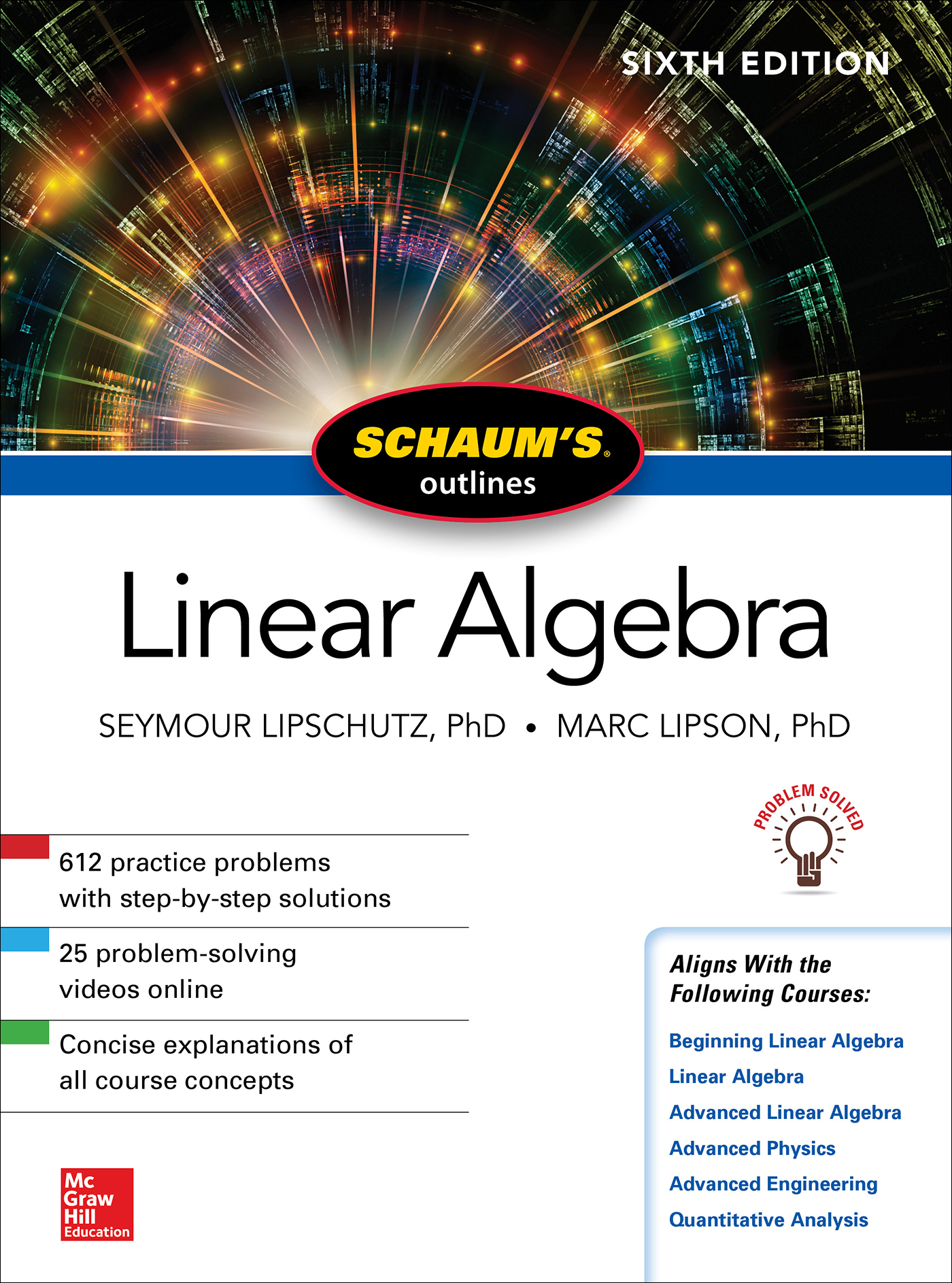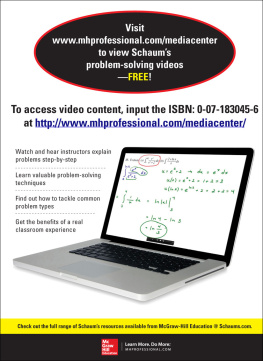Contents
Guide
Page List


Copyright 2018 by McGraw-Hill Education. Except as permitted under the United States Copyright Act of 1976, no part of this publication may be reproduced or distributed in any form or by any means, or stored in a data base or retrieval system, without the prior written permission of the publisher. ISBN: 978-1-26-001145-6
MHID: 1-26-001145-3 The material in this eBook also appears in the print version of this title: ISBN: 978-1-26-001144-9, MHID: 1-26-001144-5. eBook conversion by codeMantra
Version 1.0 All trademarks are trademarks of their respective owners. Rather than put a trademark symbol after every occurrence of a trademarked name, we use names in an editorial fashion only, and to the benefit of the trademark owner, with no intention of infringement of the trademark. Where such designations appear in this book, they have been printed with initial caps.
McGraw-Hill Education eBooks are available at special quantity discounts to use as premiums and sales promotions or for use in corporate training programs. To contact a representative, please visit the Contact Us page at www.mhprofessional.com. SEYMOUR LIPSCHUTZ is on the faculty of Temple University and formally taught at the Polytechnic Institute of Brooklyn. He received his PhD in 1960 at Courant Institute of Mathematical Sciences of New York University. He is one of Schaums most prolific authors. MARC LARS LIPSON is on the faculty of the University of Virginia and formerly taught at the University of Georgia, he received his PhD in finance in 1994 from the University of Michigan. MARC LARS LIPSON is on the faculty of the University of Virginia and formerly taught at the University of Georgia, he received his PhD in finance in 1994 from the University of Michigan.
He is also the coauthor of Discrete Mathematics and Probability with Seymour Lipschutz. TERMS OF USE This is a copyrighted work and McGraw-Hill Education and its licensors reserve all rights in and to the work. Use of this work is subject to these terms. Except as permitted under the Copyright Act of 1976 and the right to store and retrieve one copy of the work, you may not decompile, disassemble, reverse engineer, reproduce, modify, create derivative works based upon, transmit, distribute, disseminate, sell, publish or sublicense the work or any part of it without McGraw-Hill Educations prior consent. You may use the work for your own noncommercial and personal use; any other use of the work is strictly prohibited. Your right to use the work may be terminated if you fail to comply with these terms.
THE WORK IS PROVIDED AS IS. McGRAW-HILL EDUCATION AND ITS LICENSORS MAKE NO GUARANTEES OR WARRANTIES AS TO THE ACCURACY, ADEQUACY OR COMPLETENESS OF OR RESULTS TO BE OBTAINED FROM USING THE WORK, INCLUDING ANY INFORMATION THAT CAN BE ACCESSED THROUGH THE WORK VIA HYPERLINK OR OTHERWISE, AND EXPRESSLY DISCLAIM ANY WARRANTY, EXPRESS OR IMPLIED, INCLUDING BUT NOT LIMITED TO IMPLIED WARRANTIES OF MERCHANTABILITY OR FITNESS FOR A PARTICULAR PURPOSE. McGraw-Hill Education and its licensors do not warrant or guarantee that the functions contained in the work will meet your requirements or that its operation will be uninterrupted or error free. Neither McGraw-Hill Education nor its licensors shall be liable to you or anyone else for any inaccuracy, error or omission, regardless of cause, in the work or for any damages resulting therefrom. McGraw-Hill Education has no responsibility for the content of any information accessed through the work. Under no circumstances shall McGraw-Hill Education and/or its licensors be liable for any indirect, incidental, special, punitive, consequential or similar damages that result from the use of or inability to use the work, even if any of them has been advised of the possibility of such damages.
This limitation of liability shall apply to any claim or cause whatsoever whether such claim or cause arises in contract, tort or otherwise.
Preface
Linear algebra has in recent years become an essential part of the mathematical background required by mathematicians and mathematics teachers, engineers, computer scientists, physicists, economists, and statisticians, among others. This requirement reflects the importance and wide applications of the subject matter. This book is designed for use as a textbook for a formal course in linear algebra or as a supplement to all current standard texts. It aims to present an introduction to linear algebra which will be found helpful to all readers regardless of their fields of specification. More material has been included than can be covered in most first courses.
This has been done to make the book more flexible, to provide a useful book of reference, and to stimulate further interest in the subject. Each chapter begins with clear statements of pertinent definitions, principles, and theorems together with illustrative and other descriptive material. This is followed by graded sets of solved and supplementary problems. The solved problems serve to illustrate and amplify the theory, and to provide the repetition of basic principles so vital to effective learning. Numerous proofs, especially those of all essential theorems, are included among the solved problems. The supplementary problems serve as a complete review of the material of each chapter.
The first three chapters treat vectors in Euclidean space, matrix algebra, and systems of linear equations. These chapters provide the motivation and basic computational tools for the abstract investigations of vector spaces and linear mappings which follow. After chapters on inner product spaces and orthogonality and on determinants, there is a detailed discussion of eigenvalues and eigenvectors giving conditions for representing a linear operator by a diagonal matrix. This naturally leads to the study of various canonical forms, specifically, the triangular, Jordan, and rational canonical forms. Later chapters cover linear functions and the dual space V*, and bilinear, quadratic, and Hermitian forms. The last chapter treats linear operators on inner product spaces.
The main changes in the sixth edition are that some parts in Appendix D have been added to the main part of the text, that is, Chapter Four and Chapter Eight. There are also many additional solved and supplementary problems. Finally, we wish to thank the staff of the McGraw-Hill Schaums Outline Series, especially Diane Grayson, for their unfailing cooperation. SEYMOUR LIPSCHUTZ
MARC LARS LIPSON
List of Symbols
A = [
aij, matrix, 27 = [
ij], conjugate matrix, 38 |
A|, determinant, 266, 270
A*, adjoint, 379
AH, conjugate transpose, 38
AT, transpose, 33
A+, MoorePenrose inverse, 420
Aij, minor, 271
A(
I,
J), minor, 275
A(
V), linear operators, 176 adj
A, adjoint (classical), 273
A ~
B, row equivalence, 72
A B
B, congruence, 362
C, complex numbers, 11
Cn, complex
n-space, 13
C[
a,
b, continuous functions, 230
C(
f), companion matrix, 306 colsp (
A), column space, 120
d(
u, ), distance, 5, 243 diag(
a11,,
ann), diagonal matrix, 35 diag(




 Copyright 2018 by McGraw-Hill Education. Except as permitted under the United States Copyright Act of 1976, no part of this publication may be reproduced or distributed in any form or by any means, or stored in a data base or retrieval system, without the prior written permission of the publisher. ISBN: 978-1-26-001145-6
Copyright 2018 by McGraw-Hill Education. Except as permitted under the United States Copyright Act of 1976, no part of this publication may be reproduced or distributed in any form or by any means, or stored in a data base or retrieval system, without the prior written permission of the publisher. ISBN: 978-1-26-001145-6 B, congruence, 362 C, complex numbers, 11 Cn, complex n-space, 13 C[a, b, continuous functions, 230 C(f), companion matrix, 306 colsp (A), column space, 120 d(u, ), distance, 5, 243 diag(a11,, ann), diagonal matrix, 35 diag(
B, congruence, 362 C, complex numbers, 11 Cn, complex n-space, 13 C[a, b, continuous functions, 230 C(f), companion matrix, 306 colsp (A), column space, 120 d(u, ), distance, 5, 243 diag(a11,, ann), diagonal matrix, 35 diag(